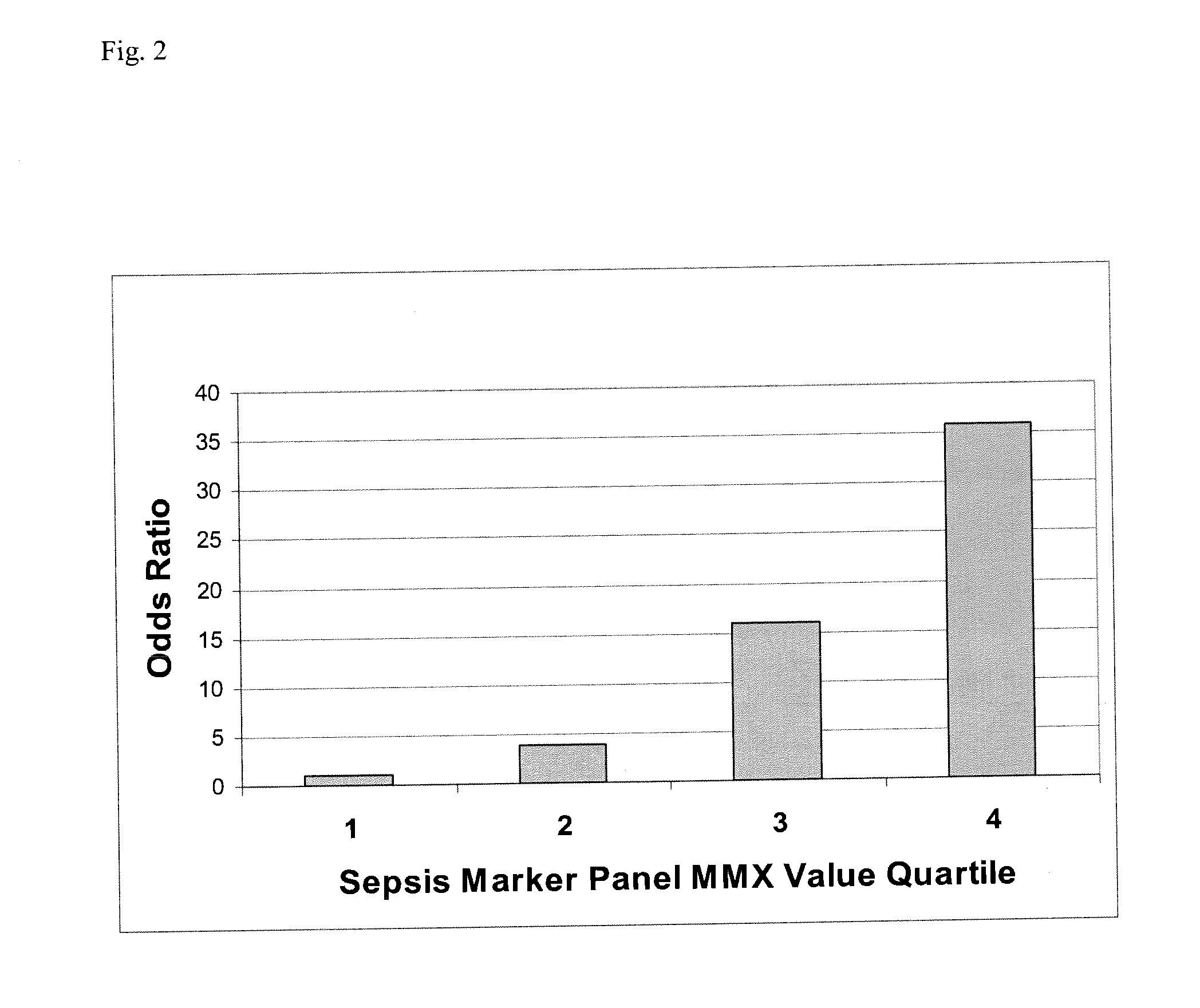Methods and compositions for diagnosis and/or prognosis in systemic inflammatory response syndromes
a systemic inflammatory response and syndrome technology, applied in the direction of instruments, suspensions and porous materials analysis, material analysis, etc., can solve the problems of not being able to unambiguously distinguish sepsis related conditions, unable to confirm 50% or more of patients exhibiting strong clinical evidence of sepsis, and not being able to identify sepsis as a particularly challenging diagnostic problem
- Summary
- Abstract
- Description
- Claims
- Application Information
AI Technical Summary
Benefits of technology
Problems solved by technology
Method used
Image
Examples
example 1
Subject Population and Sample Collection
[0159] Test subjects in disease categories were enrolled as part of a prospective sepsis study conducted by Biosite Incorporated at 10 clinical sites in the United States. Enrollment criteria were: age 18 or older and presenting with two or more SIRS criteria, and confirmed or suspected infection and / or lactate levels greater than 2.5 mmol / L. Exclusion criteria were: pregnancy, cardiac arrest, and patients under Do Not Resuscitate (DNR) orders.
[0160] Samples were collected by trained personnel in standard blood collection tubes with EDTA as the anticoagulant. The plasma was separated from the cells by centrifugation, frozen, and stored at −20° C. or colder until analysis. The plasma was frozen within 1 hour. Clinical histories are available for each of the patients to aid in the statistical analysis of the assay data. Patients were assigned a final diagnosis by a physician at the clinical site using the standard medical criteria in use at ea...
example 2
Biochemical Analyses
[0162] Analytes (e.g., markers and / or polypeptides related thereto) were measured using standard immunoassay techniques. These techniques involve the use of antibodies to specifically bind the analyte(s) of interest. Immunoassays were performed using TECAN Genesis RSP 200 / 8 or Perkin Elmer Minitrak Workstations, or using microfluidic devices manufactured at Biosite Incorporated essentially as described in WO98 / 43739, WO98 / 08606, WO98 / 21563, and WO93 / 24231. Analytes may be measured using a sandwich immunoassay or using a competitive immunoassay as appropriate, depending on the characteristics and concentration range of the analyte of interest. For analysis, an aliquot of plasma was thawed and samples analyzed as described below.
[0163] The assays were calibrated using purified proteins (that is either the same as or related to the selected analyte, and that can be detected in the assay) diluted gravimetrically into EDTA plasma treated in the same manner as the sa...
example 3
Microtiter Plate-Based Biochemical Analyses
[0165] For the sandwich immunoassay in microtiter plates, a monoclonal antibody directed against a selected analyte was biotinylated using N-hydroxysuccinimide biotin (NHS-biotin) at a ratio of about 5 NHS-biotin moieties per antibody. The antibody-biotin conjugate was then added to wells of a standard avidin 384 well microtiter plate, and antibody conjugate not bound to the plate was removed. This formed the “anti-marker” in the microtiter plate. Another monoclonal antibody directed against the same analyte was conjugated to alkaline phosphatase, for example using succinimidyl 4-[N-maleimidomethyl]-cyclohexane-1-carboxylate (SMCC) and N-succinimidyl 3-[2-pyridyldithio]propionate (SPDP) (Pierce, Rockford, Ill.).
[0166] Biotinylated antibodies were pipetted into microtiter plate wells previously coated with avidin and incubated for 60 min. The solution containing unbound antibody was removed, and the wells washed with a wash buffer, consist...
PUM
 Login to View More
Login to View More Abstract
Description
Claims
Application Information
 Login to View More
Login to View More - R&D
- Intellectual Property
- Life Sciences
- Materials
- Tech Scout
- Unparalleled Data Quality
- Higher Quality Content
- 60% Fewer Hallucinations
Browse by: Latest US Patents, China's latest patents, Technical Efficacy Thesaurus, Application Domain, Technology Topic, Popular Technical Reports.
© 2025 PatSnap. All rights reserved.Legal|Privacy policy|Modern Slavery Act Transparency Statement|Sitemap|About US| Contact US: help@patsnap.com



